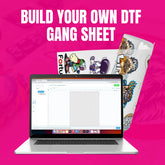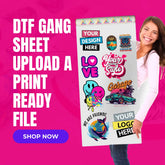Custom DTF Transfers vs. Traditional Screen Printing: What’s the Best Choice?
Two of the most often used techniques for fabric modification are custom DTF transfers and conventional screen printing. Although both have special benefits, their fit will rely on the kind of design, fabric, and manufacturing volume. More recently developed DTF transfer technology lets practically any kind of fabric print full-color, complex graphics. On the other hand, screen printing has been around for decades and is well-known in mass production for its cost-effectiveness and durability.
How Do They Differ in Design Complexity?
Custom DTF transfers have one main benefit: They are easy to handle complex, multi-colored graphics. A DTF printing machine is perfect for complicated patterns with gradients and fine details since it prints straight onto transfer film and eliminates color separation.
Conversely, screen printing calls for a different stencil—that is, screen—for every hue. Multi-color designs are, therefore, more costly and complex. While screen printing suffers with detailed artwork requiring shading or small writing, it shines with basic, strong designs.
Which Method Offers Better Durability?
Though the application technique differs, DTF heat transfers and screen printing are quite robust. Pressing ink straight into the fabric in screen printing forms a strong connection capable of withstanding repeated washing. On improper curing, nevertheless, screen prints may break over time.
Appropriately applied, DTF transfer sheets also offer great longevity. DTF heat transfers help ink bind with cloth fibers, preventing fading and breaking. DTF prints are equivalent to screen printing in a lifetime, according to studies showing they may withstand over 50 washes without notable deterioration.
Which is More Cost-Effective for Small and Large Orders?
Screen printing is often the more reasonably priced option for huge manufacturing runs. Printing in mass is quick and economical after the screens are produced. But, especially for multi-color designs, screen setup might have significant upfront expenses.
For modest orders or one-off printing, custom DTF transfers—which are free from setup costs—are perfect. DTF transfer sheets print all colors in a single pass, so color separation is not necessary, and short-run printing's labor and material costs are thus lowered.
What About Fabric Compatibility?
DTF heat transfers are one of the main benefits in that they attach to various materials. DTF printing machines may provide excellent results from cotton, polyester, leather, or mixed fabrics without specific inks or treatments.
There are less choices for fabrics in which screen printing fits. It works well on cotton and some polyester combinations but calls for different kinds of ink depending on the cloth. Printing on darker materials sometimes calls for a white underbase, which adds more steps and expenses to the operation.
Which Has a Faster Turnaround Time?
DTF gang sheets clearly win if speed is your top concern. Print, apply adhesive powder, cure, then press onto cloth—a simple technique. DTF heat transfers are perfect for fast, on-demand printing since screens are not waiting to be produced.
Screen printing requires more time for setup, particularly for multi-colored patterns. Every screen needs to be ready, aligned, and cured, which adds to the manufacturing time. Although it's great for big runs, it's not the ideal option for short turnaround tasks.
Conclusion: Which Printing Method Should You Choose?
Custom DTF transfers have advantages over screen printing. DTF heat transfers are the best option if you want premium, multi-color prints on several textiles with low setup costs. If you are creating plenty of basic patterns, though, conventional screen printing could be the most reasonably priced choice. To explore DTF transfer solutions, visit DTF Transfer Art and discover professional-quality printing options.
- Blended fabrics for DTF
- bulk dtf transfers
- bulk printing
- cost-efficient printing
- Cotton for DTF
- Custom apparel
- custom apparel printing
- Custom clothing printing
- custom gangsheet
- Custom gangsheet DTF transfer sheets
- Custom gangsheet printing
- Custom Gangsheets
- custom heat transfers
- Custom iron patches
- custom prints
- decal production
- decal transfer
- decal transfers
- Design preparation
- Digital printing
- Direct-to-Film Transfer
- dtf business
- DTF gangsheet
- DTF Heat Press
- dtf print shop
- DTF printer supplier
- DTF Printing
- dtf transfer
- dtf transfer art
- dtf transfer film
- dtf transfer instructions
- dtf transfer paper
- DTF transfer paper suppliers
- dtf transfer printer
- dtf transfer sheets
- DTF transfer supplier
- DTF transfer wholesale
- dtf transfers
- dtf transfers near me
- dtf transfers ready to press
- dtf transfers wholesale
- DTF vs Screen Printing
- DTF vs Vinyl
- DTF vs. iron-on
- dtf wholesale
- gangsheet printing
- heat press printing
- Heat press settings
- Heat settings for DTF
- heat transfer decals
- heat transfer method
- heat transfer printing
- Heat transfers
- hoodie printing
- Hoodies
- hot peel DTF
- iron-on decals
- Jerseys
- Leather DTF transfers
- Local print shops
- Mild detergent for DTF prints
- model decals
- Nylon DTF transfer
- Peeling or cracking prevention
- Polyester for DTF
- premium DTF transfers
- print on demand
- Print shops near me
- Printed designs durability
- Printing companies
- Printing methods
- Quality printing
- reliable DTF transfer printer supplier
- Screen printing
- Spandex DTF transfer
- sticker printing
- Stretch fabrics DTF
- t shirt printing
- T-shirts
- Tote bags
- Transfer printing
- trustworthy DTF transfer supplier
- vinyl decals
- Washing care for DTF prints
- what is dtf transfer






